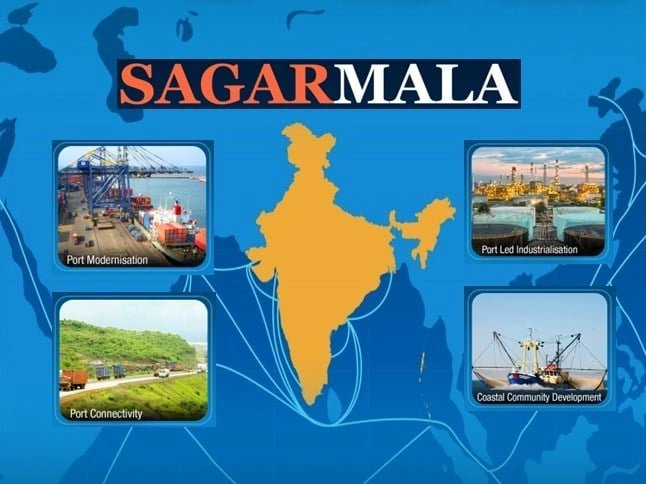Coastal Shipping in India: Port-Led Development Explained
India’s extensive 7,500 km coastline positions it uniquely to harness the potential of coastal shipping as a catalyst for economic growth. The nation’s strategic initiatives, notably the Sagarmala Programme and the recently enacted Coastal Shipping Bill, 2024, underscore a commitment to transforming maritime logistics and integrating port-led development into the broader economic framework.DD News+4CG Logistic+4sagarmala.gov.in+4
Understanding Port-Led Development
Port-led development is a strategic approach that leverages port infrastructure to stimulate industrialization, trade, and economic growth. By integrating ports with hinterland connectivity through road, rail, and inland waterways, this model aims to create Coastal Economic Zones (CEZs), fostering employment and regional development.
The Sagarmala Programme, initiated in 2015, embodies this vision by focusing on:CG Logistic+2sagarmala.gov.in+2Wikipedia+2
-
Port Modernization: Upgrading existing ports to enhance capacity and efficiency.
-
Port Connectivity Enhancement: Improving road, rail, and inland waterway links to ports.
-
Port-Linked Industrialization: Developing CEZs and industrial clusters near ports.
-
Coastal Community Development: Empowering coastal communities through skill development and livelihood opportunities.Wikipedia+3Wikipedia+3Wikipedia+3PWOnlyIAS
For more details, visit the Sagarmala Programme.sagarmala.gov.in
The Coastal Shipping Bill, 2024: A Legislative Milestone
The enactment of the Coastal Shipping Bill, 2024, marks a significant step in streamlining coastal trade. This legislation replaces outdated provisions of the Merchant Shipping Act, 1958, providing a modern framework to regulate coastal shipping activities.News On Air+7Business Standard+7Avantis CDN Production Storage+7Business Standard+2Swaniti Initiative+2Lexology+2
Key features include:
-
Simplified Licensing: Easier registration and licensing processes for coastal vessels.
-
Enhanced Regulation: Clear guidelines for vessel operations within India’s territorial waters.
-
Promotion of Indigenous Shipping: Encouraging the use of domestically built and operated vessels.
-
Integration with National Logistics Policy: Aligning coastal shipping with broader logistics and transportation strategies.
This bill aims to increase the modal share of coastal shipping from the current 6.4% to 12% by 2047, reducing the burden on road and rail networks.Swaniti Initiative
For an in-depth overview, refer to the Coastal Shipping Bill, 2024.PRS Legislative Research

Infrastructure Developments: Catalyzing Growth
Several infrastructure projects are underway to bolster coastal shipping:
-
Greenfield Ports: States like Andhra Pradesh are developing new ports at Mulapeta, Kakinada Gateway, Machilipatnam, and Ramayapatnam to enhance cargo handling capacity.APIIC
-
Shipbuilding Clusters: A shipbuilding and repair cluster is being established in Nellore district, Andhra Pradesh, spanning 2,000 acres, aiming to attract investments and generate employment.The Times of India
-
Highway Connectivity: The Union government has approved a ₹1,400 crore highway project in Andhra Pradesh to connect the Nizampatnam fishing harbour with the proposed Amaravati Outer Ring Road, enhancing regional connectivity.The Times of India
These initiatives are part of a broader strategy to develop coastal infrastructure and stimulate economic growth.
Economic Implications: Harnessing the China+1 Strategy
India stands to benefit from the global shift in manufacturing and supply chains, known as the China+1 strategy. As companies seek alternatives to China, India’s ports are poised to experience increased activity, bolstering trade volumes and logistics operations.The Times of India
According to Moody’s Ratings, this shift is expected to enhance India’s infrastructure and economic growth through expanded port usage and greater international commerce.The Times of India
For more insights, read the Moody’s report.The Times of India
Sustainable Shipping: Aligning with Environmental Goals
Sustainability is becoming integral to India’s maritime strategy. Initiatives include developing green hydrogen hubs and implementing shore-power mandates to reduce maritime emissions. These efforts aim to position Indian ports and fleets as environmentally responsible and globally competitive.@EconomicTimes
Arun Awasthy, President & Managing Director of Johnson Controls India, emphasized the importance of sustainable shipping in enhancing India’s economic competitiveness.@EconomicTimes
Learn more about sustainable shipping initiatives in India here.@EconomicTimes
Conclusion
India’s focus on coastal shipping and port-led development is reshaping its economic landscape. Through legislative reforms, infrastructure investments, and sustainable practices, the country is poised to enhance its maritime capabilities, reduce logistics costs, and stimulate regional development.
As these initiatives progress, they hold the promise of transforming India’s coastal regions into vibrant hubs of trade and industry, contributing significantly to the nation’s economic growth India-Agent.com.
